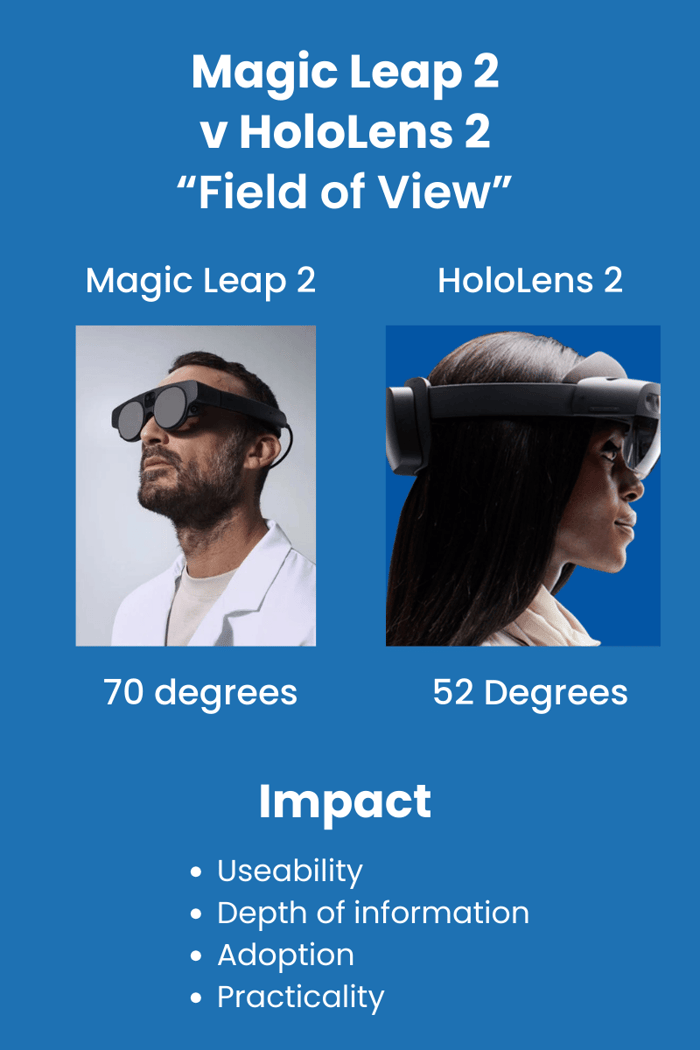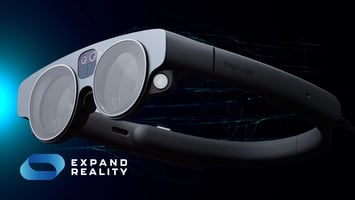Augmented Reality is becoming a very valuable tool in the manufacturing industry and a recent case...
Magic Leap 2 V HoloLens 2
Magic Leap 2 vs. HoloLens 2: A Comprehensive Comparison for Enterprise AR Use
When it comes to augmented reality (AR) headsets, both the Magic Leap 2 and the Microsoft HoloLens 2 are frontrunners in delivering innovative mixed reality solutions. However, their approaches to enterprise applications differ significantly, making each more suitable for specific use cases.
Adding a new layer of competition, Microsoft recently bolstered its presence in the virtual reality (VR) market by making its Office suite and Microsoft Mesh fully compatible with the Meta Quest 3. At the same time, Magic Leap announced $590M in funding for its “Scale and Adoption” phase, signalling the company's commitment to expanding enterprise adoption of its hardware.
Here, we’ll break down the pros, cons, and specifications of both devices and highlight five key areas where Magic Leap 2 has a distinct edge for enterprise users.
5 Practical Areas of Headset Advantage
-
Display Quality and Resolution
-
Magic Leap 2: Offers a field of view (FoV) of 70°, significantly wider than the HoloLens 2's 52° FoV, making it easier to interact with virtual content in expansive settings. It also features dynamic dimming, allowing users to adjust the brightness of virtual objects against various real-world environments for improved clarity.
-
HoloLens 2: While the display quality is sharp and supports a resolution of 2048 x 1080 per eye, it lacks the adaptive dimming technology, which may limit its usability in brightly lit environments.
-
-
Weight and Comfort
-
Magic Leap 2: Weighing just 260g for the headset (excluding the compute pack), it’s lighter than the HoloLens 2 and more comfortable for all-day wear. The compute pack adds modular flexibility, enabling users to carry the processing unit on their belt.
-
HoloLens 2: The all-in-one design simplifies setup but adds weight (566g), which can become uncomfortable during extended use.
-
-
Compatibility with Enterprise Software
-
Magic Leap 2: Supports popular AR headset platforms and integrates seamlessly with Linux-based enterprise systems, making it a great choice for technical fields like healthcare and manufacturing.
-
HoloLens 2: Its deep integration with Microsoft’s ecosystem, including Azure, Dynamics 365, and now Microsoft Mesh, makes it the go-to device for businesses already leveraging Microsoft software.
-
-
Price and Accessibility
-
Magic Leap 2: Priced at $3,299, it targets enterprise users with premium requirements.
-
HoloLens 2: Starting at $3,500, the HoloLens 2 is slightly more expensive but offers value for companies already using Microsoft's cloud infrastructure.
-
-
Use Case Versatility
-
Magic Leap 2: Excels in precision-based industries, including surgery, design prototyping, and environments requiring accurate virtual overlays.
-
HoloLens 2: Best suited for collaborative tasks, remote assistance, and large-scale enterprise deployments due to its robust Microsoft Teams and Mesh integration.
-
Magic Leap 2 v HoloLens 2 Headset Weight
Magic Leap 2 vs. HoloLens 2: Key Specifications at a Glance
|
Feature |
Magic Leap 2 |
HoloLens 2 |
|---|---|---|
|
Field of View (FoV) |
70° |
52° |
|
Resolution |
1440 x 1760 per eye |
2048 x 1080 per eye |
|
Weight |
260g (headset only) |
566g |
|
Operating System |
Android |
Windows 10 Holographic |
|
Price |
$3,299 |
$3,500 |
Pros and Cons of Each Device
Magic Leap 2 Pros:
-
Lightweight and modular design
-
Advanced dynamic dimming for mixed lighting conditions
-
Wider FoV enhances immersion
Magic Leap 2 Cons:
-
Limited integration with Microsoft’s software ecosystem
-
Requires separate compute pack
HoloLens 2 Pros:
-
Seamless compatibility with Microsoft Azure and Teams
-
Strong enterprise collaboration tools
HoloLens 2 Cons:
-
Heavier, less comfortable for prolonged use
-
Smaller field of view
Which AR Headset is Right for You?
The choice between the Magic Leap 2 and the HoloLens 2 comes down to your enterprise needs:
-
If you prioritise lightweight design, dynamic dimming, and wide FoV, the Magic Leap 2 is your best bet.
-
For businesses deeply embedded in Microsoft’s ecosystem or needing mixed reality for collaboration, the HoloLens 2 is a natural fit.
Stay ahead in the AR space by choosing the headset that aligns with your enterprise goals and workflow.
Magic Leap 2 v HoloLens 2 Field of View

The Field of View Advantage: Why Magic Leap 2 Outshines HoloLens 2
When comparing Magic Leap 2 vs. HoloLens 2, one of the most significant advantages is Magic Leap 2’s field of view (FoV)—a 34% larger area than the HoloLens 2. This expanded FoV transforms the usability and overall experience, especially for enterprise adoption, by allowing users to interact with augmented reality (AR) content in a way that feels more natural and immersive.
Key Considerations: Why Field of View Matters
-
Usability
-
The Magic Leap 2’s FoV measures 70 degrees diagonal, compared to the HoloLens 2’s 52 degrees. This larger visual canvas ensures digital aids and real-world views coexist seamlessly. For tasks requiring precise tracking, this is crucial as users can focus on both digital overlays and their physical environment without frequent head movements.
-
The HoloLens 2, while capable, can feel restrictive in comparison, as its narrower FoV may limit the user’s ability to view virtual objects in full without repositioning their head.
-
-
Depth of Information
-
A larger FoV allows for layered depth in visual displays. The Magic Leap 2 excels at presenting more detailed, spatially arranged information, enabling users to multitask effectively. For example, surgeons can view patient vitals while focusing on procedures, or engineers can overlay schematics without crowding their view.
-
The HoloLens 2 is optimised for Microsoft-centric workflows, which may prioritise ease of use within applications like Dynamics 365 or Microsoft Mesh, albeit with a narrower scope of visible information at any given moment.
-
-
Adoption
-
The Magic Leap 2’s wider FoV is a game-changer for industries requiring high situational awareness, such as healthcare, manufacturing, and logistics. This feature enhances ease of use and lowers the learning curve for new users.
-
While the HoloLens 2 remains a strong choice for enterprises deeply integrated into the Microsoft ecosystem, its smaller FoV might deter adoption in environments where visual clarity and spatial awareness are paramount.
-
-
Practicality
-
The Magic Leap 2’s FoV advantage directly translates to more practical use cases, such as interactive training, remote assistance, and complex workflows requiring extensive virtual aids.
-
The HoloLens 2’s practicality lies in its seamless integration with Microsoft’s tools, but it may struggle in scenarios requiring expansive visual interactions.
-
The Reality Showdown: Field of View
|
Factor |
Magic Leap 2 |
HoloLens 2 |
|---|---|---|
|
Field of View |
70° diagonal |
52° diagonal |
|
Usability |
Enhanced multitasking, intuitive tracking |
Better for focused, Microsoft-based tasks |
|
Depth of Information |
Supports more layered and immersive visuals |
Limited to smaller visual real estate |
|
Adoption |
Favoured in high-precision industries |
Stronger in Microsoft-aligned workplaces |
|
Practicality |
Ideal for detailed, immersive workflows |
Suited for static, software-driven tasks |
Why Field of View Matters for Enterprise AR
-
Tracking and Design: The Magic Leap 2’s advanced optics and tracking capabilities enhance spatial precision. Its Magic Leap Hub streamlines content management and deployment, further solidifying its usability for enterprise demos and hands-on applications.
-
Ease of Use: A larger FoV reduces the cognitive load on users, enabling them to interact with both the real world and virtual content more intuitively.
-
Adoption Rates: A superior FoV makes the Magic Leap 2 a more appealing choice for industries prioritising immersive experiences over software compatibility.
The Magic Leap 2’s field of view advantage sets it apart as a leader in augmented reality for enterprise use. Its larger visual workspace allows for enhanced tracking, richer depth of information, and a more immersive experience, making it the ideal choice for tasks requiring precision and extended wearability. While the HoloLens 2 remains a powerful tool for Microsoft-driven workflows, its narrower FoV may limit its appeal in environments that demand expansive AR visualisations.
Magic Leap 2 v HoloLens 2 Input Methods
Whereas both headsets accommodate voice control, gesture control and eye tracking, the Magic Leap 2 has head posture and a hand based controller to add further flexibility as options to everyday use. You want to consider the impact:
-
Usability
-
Flexibility
-
Sub Millimeter Precision
-
Practicality
Magic Leap 2 v HoloLens 2 Dimmable Technology
The next really is the difference between night and day. For those of you that have tried to use a mobile device in broad daylight and still see the screen you'll be familiar with this issue.
Dimmable technology gives you the ability to dim or enlighten the screen so that you get the right amount of light on the situation that your task requires. You want to consider the impact:
-
All Light Conditions
-
Bright Light Wearability
-
Dark Light Wearability
-
Practicality
Magic Leap 2 v HoloLens 2 Compute
Last but not least is the compute power of the AMD chipset which is up to 32% faster depending on the software application, but speed is always key when dealing with time critical situations in enterprise, blue light or healthcare medical situations. You want to consider the impact:
-
Speed
-
Productivity
-
Adoption
Magic Leap 2 v HoloLens 2 Comparison Infographic
Below is a handy PDF that outlines the key features of the Magic Leap 2 device in comparison with the HoloLens 2. You can download to win the user community over as to why your considering one rather than the other by comparing the augmented reality devices .
What you should know
HoloLens 2 More Information
- HoloLens Augmented Reality
- HoloLens Download Centre
- HoloLens Case Studies
- HoloLens manufacturers Page
- HoloLens 2 v Magic leap 2 Comparison
- HoloLens Full Information Page
- HoloLens Device Analysis
- holoLens 2 v Magic leap 2 field of View
- HoloLens FAQ's
- HoloLens all you need to know
- HoloLens 2 and augmented reality
- HoloLens 2 XR analysis of the device
- Blog HoloLens 2 v Magic Leap 2
Magic Leap 2 Useful Links
3 exciting use cases for Magic Leap 2
Magic Leap , Siemens and the Javits Centre
Magic Leap 2 and Manufacturing Training with Manifest Software.
Magic Leap 2 Medical Holodeck - Training and Operating Use Cases
Augmented Reality Links
Field of View in Augmented Reality: Magic Leap 2's Advantages
Magic Leap 2 - Augmented Reality Service Launched

.png?width=600&height=338&name=Magic%20Leap%202%20V%20HoloLens%202%20(5).png)



.png?width=700&height=1050&name=3%20(1).png)
.png?width=600&height=1500&name=Magic%20Leap%202%20V%20HoloLens%202%20(6).png)


